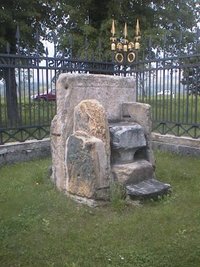Karantania
|
|
Karantania_597.png
Karantania with Carniola around 597
Karantania with Carniola around 597
Karantania sometimes Carantania, Carentania, Carinthia (in old Slovenian onomastics Korotan, or Karantanija) was the first stable and independent state of Slovenians and of Slavs. Founded in the 6th century it lasted almost 300 years.
| Contents |
Timeline
The first mention of this state in official documents has been dated to 595, according to present knowledge. Some older historians cite a date of 745, while others claim one even later. The label of the first Slavic state is a topic of some controversy. The Czechs proclaim to be descended from Samo's kingdom (623) and from Great Moravia (833).
Latin authors named the Gorostan (archaic Mountain Home), a mountainous fatherland of Slovenian ancestors north of Karavanke with the name Carantanum. Carinthia can also be derived from the name for Carni, a Celtic people.
Around 611 Karantanians passed over Bavarian territory near the wellspring of the river Drave (Drava) and devastated it without the help of neighbouring Avars.
After 620 Karantania was joined to Samo's state union (623) with the name marca Vinedorum. It was ruled by the duke Valuk (Wallux dux Winedorum). In 658 Samo died and the Slav tribal union collapsed. Smaller Karantania persisted.
In 745 Karantania lost its independence and became a margraviate and tantamount part of the semifeudal Frankish empire later under the rule of king Charlemagne (742-814, reigned 771-814) due to pressing danger of Avar tribes from the east.
In 843 Karantania passed into the hands of Louis the German (804-876). In 887 Arnulf of Carinthia (850-899) a grandson of Louis the German assumed his title of King of the East Franks and became the first Duke of Carinthia.
Literary repercussions
Dante Alighieri (1265-1321) mentions Karantania as Chiarentana. The same name was used by Florentines such as a poet Fazio degli Uberti (circa 1309-1367), the famous chronicler Giovanni Villani (c. 1275-1348) and Giovanni Boccaccio (1313-1375), who said that the river Brenta rises from the mountains of Karantania, that is a land in Alps, which divide Italy from Germany.
The Ducal Coronation
The ancient ritual of installing Karantanian dukes carried out in Slovenian language on the Prince's Stone (Slov. Knežji kamen, German Fürstenstein), an Ancient Celtic column, near Krnski grad, (now Karnburg) by a free farmer selected by his peers who questioned the new duke about his integrity. Subsequently, the new Duke had to swear an oath while sitting on the Duke's Chair (Slov. Vojvodski stol, German Herzogsstuhl), where he also received the homage of the estates. The Chair was located at the Gosposvetsko Field (Slov. Gosposvetsko polje), which is today known in German as the Zollfeld north of Klagenfurt (Slov. Celovec) in Carinthia, Austria. This ceremony was conducted the last time in 1414, when the Habsburg Ernest the Iron was enthroned as Duke of Carinthia. Some say that the ritual inspired Thomas Jefferson in writing the United States Declaration of Independence in 1776 as he read about it in the Jean Bodin's Six livres de la Republique.
References
- Jožko Šavli, Slovenska država Karantanija (Slovenian state of Karantania), (Založba Lipa, Koper; Editiones Veneti, Dunaj (Vienna); Karantanija, Ljubljana 1990).
See also
External links
- Historical information (http://www.niagara.com/~jezovnik/korenine_part_ii.htm)
- The Ducal Coronation (http://www.aeiou.at/aeiou.encyclop.h/h541237.htm;internal&action=_setlanguage.action?LANGUAGE=en)pl:Karantania

